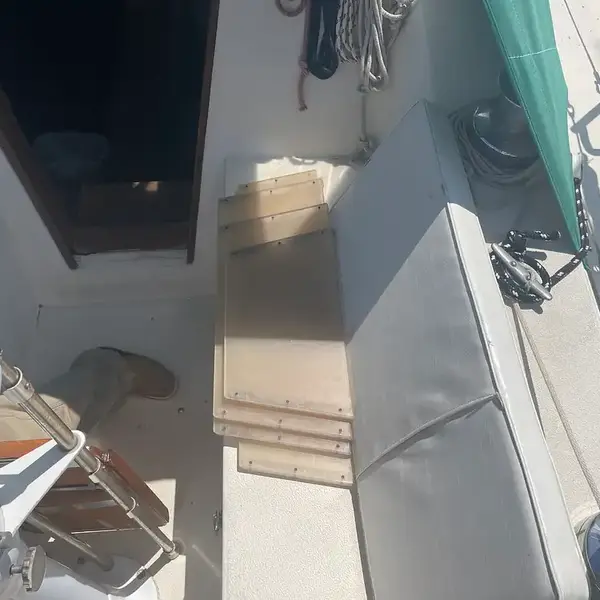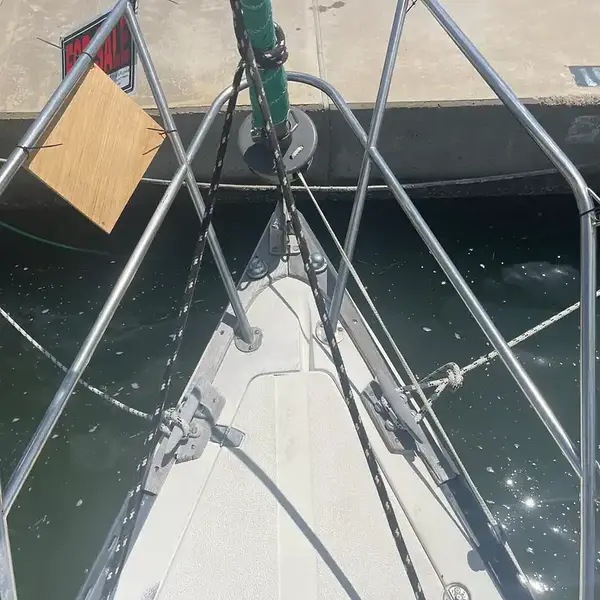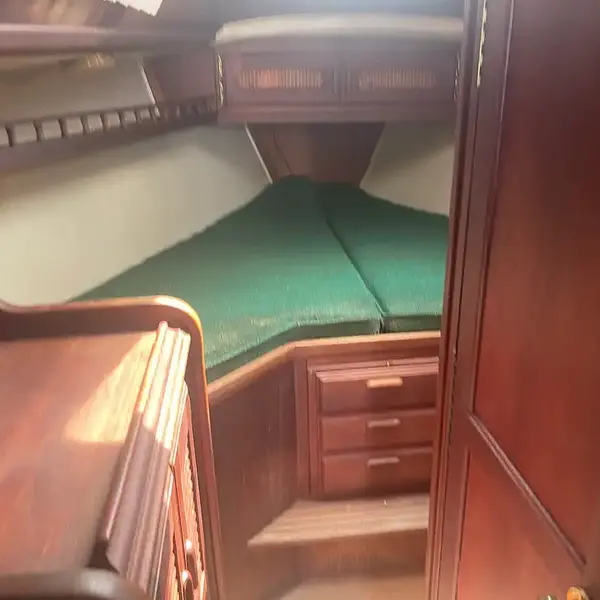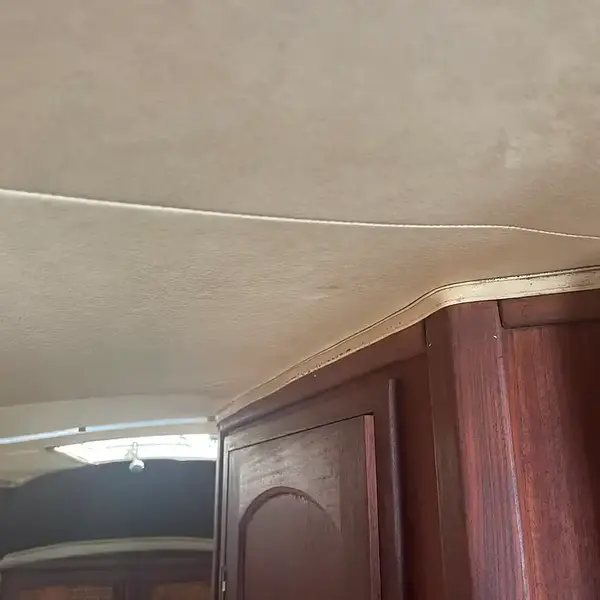Seller's Description
The 1978 Islander 32 sailboat is a classic cruising sailboat known for its solid construction, comfortable interior, and capable sailing performance. It was designed by renowned naval architect Robert Finch and built by Islander Yachts, a company known for producing quality boats.
The Islander 32 features a moderate displacement hull design, which strikes a balance between stability and performance. The hull is made of fiberglass, providing durability and resistance to the marine environment. The boat’s lines are clean and timeless, reflecting the design sensibilities of the era.
The sail plan of the Islander 32 includes a relatively large mainsail and a foretriangle that can accommodate a genoa or jib. This configuration allows for versatility in various wind conditions. While not designed for racing, the Islander 32 is known to offer a comfortable and stable sailing experience, making it suitable for coastal cruising and extended voyages.
One of the standout features of the Islander 32 is its spacious and well-thought-out interior. The layout is a forward cabin with a V-berth, offering sleeping accommodations for two. The main salon features a central table surrounded by settees that can be converted into additional berths, a navigation station with space for charts, navigation instruments, and communication equipment.
The Islander 32 sailboat includes amenities for comfortable cruising, such as ample storage throughout the interior, portlights and hatches for ventilation and natural light, and thoughtful touches like handholds and secure fittings to enhance safety while underway.
The Islander 32 is considered a classic sailboat design that has stood the test of time. The Islander 32 remains a sought-after boat on the used market due to its reputation for seaworthiness and livability.
Specs
- Designer
- Robert Perry
- Builder
- Islander / Tradewind Yachts
- Associations
- ?
- # Built
- ?
- Hull
- Monohull
- Keel
- Fin
- Rudder
- Spade
- Construction
- FG
Dimensions
- Length Overall
- 31′ 11″ / 9.7 m
- Waterline Length
- 25′ 0″ / 7.6 m
- Beam
- 11′ 1″ / 3.4 m
- Draft
- 5′ 3″ / 1.6 m
- Displacement
- 10,500 lb / 4,763 kg
- Ballast
- 4,200 lb / 1,905 kg
Rig and Sails
- Type
- Sloop
- Reported Sail Area
- 475′² / 44.1 m²
- Total Sail Area
- 474′² / 44.1 m²
Mainsail
- Sail Area
- 186′² / 17.3 m²
- P
- 36′ 4″ / 11.1 m
- E
- 10′ 2″ / 3.1 m
- Air Draft
- ?
Foresail
- Sail Area
- 289′² / 26.8 m²
- I
- 41′ 11″ / 12.8 m
- J
- 13′ 8″ / 4.2 m
- Forestay Length
- 44′ 2″ / 13.5 m
Auxilary Power
- Make
- Volvo
- Model
- MD7A
- HP
- 13
- Fuel Type
- Diesel
- Fuel Capacity
- ?
- Engine Hours
- ?
Accomodations
- Water Capacity
- ?
- Holding Tank Capacity
- ?
- Headroom
- ?
- Cabins
- ?
Calculations
- Hull Speed
-
7.0 kn
Classic: 6.7 kn
Hull Speed
The theoretical maximum speed that a displacement hull can move efficiently through the water is determined by it's waterline length and displacement. It may be unable to reach this speed if the boat is underpowered or heavily loaded, though it may exceed this speed given enough power. Read more.
Formula
Classic hull speed formula:
Hull Speed = 1.34 x √LWL
A more accurate formula devised by Dave Gerr in The Propeller Handbook replaces the Speed/Length ratio constant of 1.34 with a calculation based on the Displacement/Length ratio.
Max Speed/Length ratio = 8.26 ÷ Displacement/Length ratio.311
Hull Speed = Max Speed/Length ratio x √LWL
- Sail Area/Displacement
-
15.9
<16: under powered
Sail Area / Displacement Ratio
A measure of the power of the sails relative to the weight of the boat. The higher the number, the higher the performance, but the harder the boat will be to handle. This ratio is a "non-dimensional" value that facilitates comparisons between boats of different types and sizes. Read more.
Formula
SA/D = SA ÷ (D ÷ 64)2/3
- SA: Sail area in square feet, derived by adding the mainsail area to 100% of the foretriangle area (the lateral area above the deck between the mast and the forestay).
- D: Displacement in pounds.
- Ballast/Displacement
-
40.0
>40: stiffer, more powerful
Ballast / Displacement Ratio
A measure of the stability of a boat's hull that suggests how well a monohull will stand up to its sails. The ballast displacement ratio indicates how much of the weight of a boat is placed for maximum stability against capsizing and is an indicator of stiffness and resistance to capsize.
Formula
Ballast / Displacement * 100
- Displacement/Length
-
300.0
300-400: heavy
Displacement / Length Ratio
A measure of the weight of the boat relative to it's length at the waterline. The higher a boat’s D/L ratio, the more easily it will carry a load and the more comfortable its motion will be. The lower a boat's ratio is, the less power it takes to drive the boat to its nominal hull speed or beyond. Read more.
Formula
D/L = (D ÷ 2240) ÷ (0.01 x LWL)³
- D: Displacement of the boat in pounds.
- LWL: Waterline length in feet
- Comfort Ratio
-
24.1
20-30: coastal cruiser
Comfort Ratio
This ratio assess how quickly and abruptly a boat’s hull reacts to waves in a significant seaway, these being the elements of a boat’s motion most likely to cause seasickness. Read more.
Formula
Comfort ratio = D ÷ (.65 x (.7 LWL + .3 LOA) x Beam1.33)
- D: Displacement of the boat in pounds
- LWL: Waterline length in feet
- LOA: Length overall in feet
- Beam: Width of boat at the widest point in feet
- Capsize Screening
-
2.0
>2.0: better suited for coastal cruising
Capsize Screening Formula
This formula attempts to indicate whether a given boat might be too wide and light to readily right itself after being overturned in extreme conditions. Read more.
Formula
CSV = Beam ÷ ³√(D / 64)
- Beam: Width of boat at the widest point in feet
- D: Displacement of the boat in pounds
Notes
Shoal draft: 4.0’.
This listing is presented by PopYachts.com. Visit their website for more information or to contact the seller.








































































































